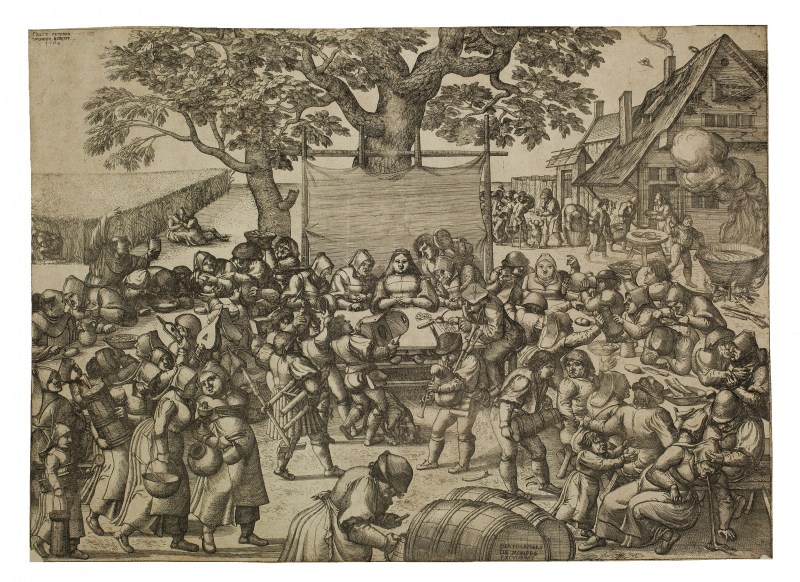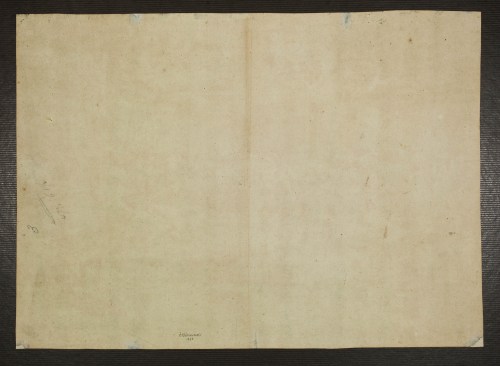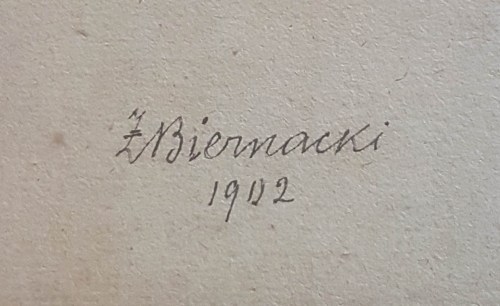Pieter van der BORCHT: The Large Wedding Feast - 1560
SOLD
Etching, 365 to 367 mm x 505 to 510 mm (sheet). New Hollstein 172, 1st state (of 2).
Impression of the 1st state (of 3; of 2 according to New Hollstein), with the date 1560 and before the reworks and censorship.
Hans and Ursula Mielke (New Hollstein) describe two states: on impressions of the first state, as the one we present here, the date 1560 is engraved below Pieter van der Borcht’s signature in the upper left corner; this date is erased on impressions of the 2nd state. There are also impressions of an intermediate state printed from the plate yet with the date 1560 but which had already been reworked because it was worn-out and also in order to black out the two monks at the far left of the plate. On impressions from the 2nd and 3rd states, these two monks have been turned into ordinary peasants by adding hairs or a hat on their tonsure (see Hessel Miedema, p. 193). An impression of this intermediary state (or 2nd state of 3) has been sold by Christie’s on 25th January 2017 (described by mistake as an impression of the 1st state of 2). The address of the Antwerpian publisher Bartholomeus de Momper (1535-1597) is engraved on impressions of all three states.
Very fine impression printed on laid watermarked paper : post-horn in a coat of arms, very similar to Briquet 7862 (Brabant 1593 and Middelbourg 1591) but larger (54 x 43 mm). Generally in very good condition. Three very small traingular losses of paper (10 x 10 mm, 10 x 3 mm and 7 x 3 mm) in the bottom corners and on the upper edge and two small tears (13 and 17 mm) on the bottom and upper edges of the sheet. A slight vertical trace of rubbing towards the center of the sheet.
Provenance: hand-written collection mark of Z. Biernacki (Lugt 3094) and date 1902 on the reverse.
The 1560 engraving The Large Wedding Feast by Pieter van der Borcht is part of a long tradition depicting village fairs, country scenes of daily life and peasant customs. In these images it can be difficult to tell whether the painter celebrates these customs while poking fun at them, or whether he is trying to denounce their immorality. Pieter van der Borcht's oeuvre contains a number of these scenes of peasant life; they in turn inspired his contemporaries, including Pieter Bruegel the Elder.
In the centre of a symmetrical composition, the bride is pictured sat at a table with a large sheet hung behind her, as is customary. Her arms are folded in a dignified way, thereby signalling that she is not partaking in the excesses of the banquet: there is, in front of her, no food or drink. Borcht wasn’t kind to her: he made her fat-cheeked and cross-eyed. These comical traits can be found in some wedding feasts painted for example in the Verbeeck family workshop, active in Mechelen in the 16th century (see Vandenbroeck, p. 93).
Sat at the bridal table, upon which coins are heaped, a clerk takes note of the gifts brought by the guests, under the watchful eye of an old woman. Young urchins play rowdily in front of the table, bringing, one a commode, another one a chamber pot. Behind them, each guest brandishes a present: a salt cellar, a stool, a candleholder, a stockpot, a butter churn, a distaff, a bellows, tongs, pots, ladles…
The rest of the picture offers the usual depiction of banquets, with bawdy and comical scenes. Hessel Miedema points out that Pieter van der Borcht's The Large Wedding Feast features four essential aspects that are commonly found in contemporary representations of peasant wedding feasts: gifts to the bride, the banquet, music and almsgiving. In his opinion, Pieter van der Borcht created this print specifically for the Antwerp market, with the objective of offering a detailed and amusing look at peasant wedding customs (Miedema p. 194). However, there is no dancing in this picture, whereas dance will be the main subject of Pieter Bruegel’s sketch Rustic Wedding Dance, engraved by Pieter van der Heyden and published by the widow of Hieronymus Cock after 1570. The similarities between Pieter van der Borcht’s engraving and Bruegel’s drawing are well known. Nadine Orenstein noted: “The initial conception of the theme was no doubt inspired by a 1560 engraving by Pieter van der Borcht showing a peasant wedding.” (Orenstein and al. p. 250). More specifically, Bruegel adopted the same high-angle view, which gives us a glimpse of the guests in the background, bearing all sorts of motley gifts to the bride, who is surrounded, as in van der Borcht’s engraving, by a clerk and several old crones.
References: Hessel Miedema: « Feestende boeren - lachende dorpers. Bij twee recente aanwinsten van hetRijksprentenkabinet » in Bulletin van het Rijksmuseum, Jaarg. 29, no. 4 (1981), pp. 191-213; Paul Vandenbroeck: « Verbeeck's Peasant Weddings: A Study of Iconography and Social Function » in Simiolus: Netherlands Quarterly for the History of Art, Vol. 14, no. 2 (1984), pp.79-124; Eddy de Jongh and Ger Luijten: Mirror of everyday life, Genreprints in the Netherlands, 1550-1700, 1997; Nadine M. Orenstein and al.: Pieter Bruegel the Elder: Drawings and Prints, 2001; Hans and Ursula Mielke: Peeter van der Borcht, 2004; Manfred Sellink: Bruegel, L’œuvre complet, peintures, dessins, gravures, 2007.





